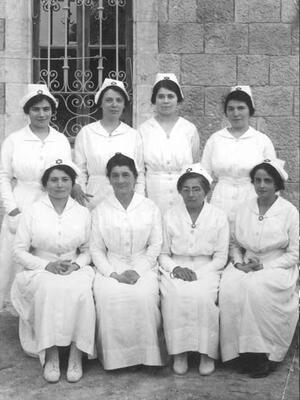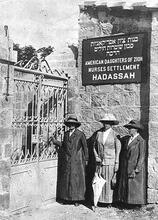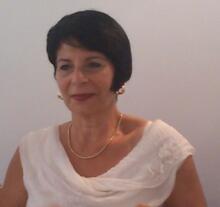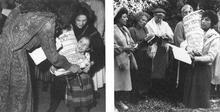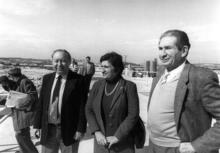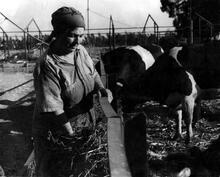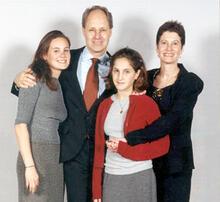Nursing as a Female Profession in Palestine (1918-1948)
The first nursing school in Palestine, the Hadassah School of Nursing, was founded in 1918. It hoped to revolutionize nursing education in the Yishuv by following the British and American models that treated nurses as professionals and academics. The women in Hadassah faced pushback from (male) doctors in the Yishuv, as well as from Hadassah leadership in New York, who struck down the establishment of any academic nursing institutions in Palestine. Nurses continued to band together in professional organizations and advocate for their interests, and they were essential figures during the many bouts of war and violence that preceded the establishment of the state of Israel.
Nursing’s struggle to hold its own as a profession was part and parcel of the activity of the women’s movement in the United States, mainly from the nineteenth century to the 1920s. The struggle of women who also wanted nursing to gain professional recognition in Palestine took place within that context.
The idea of training local women to carry out limited, specific activities necessary to the functioning of medical institutions was accepted until the Mandate for Palestine given to Great Britain by the League of Nations in April 1920 to administer Palestine and establish a national home for the Jewish people. It was terminated with the establishment of the State of Israel on May 14, 1948.British Mandate period, but then gradually evolved into the perception of nursing as a profession to be filled by registered nurses.
The nursing school at Hadassah, a leading medical institution in the country at the time, was the first post–high-school professional training center for women in the country. The members of the AZMU (American Zionist Medical Unit, later the Hadassah Medical Organization), who founded the nursing school in 1918 brought about a revolution in the nursing field in the country and designed a model to be emulated. Operating along the lines of nursing in the United States and Great Britain, the school was based on three years of study, a curriculum, knowledge of professional literature, teaching staff, tests, a license from the British government, and dormitories, all of which were unknown in Palestine at the time.
The revolution in nursing was one aspect of the Zionist revolution in Palestine. The notion of a Jewish nurse who participated in the wellness enterprise was yet another expression of the developing local culture, which also included staying healthy and preserving physical and spiritual hygiene. It was also part of increasing professionalization of Jewish community in Palestine prior to the establishment of the State of Israel. "Old Yishuv" refers to the Jewish community prior to 1882; "New Yishuv" to that following 1882.Yishuv society. The “new woman,” an independent entrepreneur and professional health-care provider, differed from her predecessors, who were usually nuns or women on the fringes of society.
Nurses as Academics? Debates of the 1930s
Until the beginning of the 1930s the status of nurses at Hadassah was high, particularly in the area of public health, which was considered important. During this period, the nurses worked together with women’s movements such as the Histadrut Nashim Ivriot (Hebrew Women’s Organization) (Shvarts 2001). But later, as the medical and natural sciences developed as “men’s fields” (as part of the university hospital in Jerusalem) that nurses could not enter, they suffered a decline in status.
The women who directed the nursing school fought Hadassah’s management, which recognized the school’s existence as a source of workers but prevented it from gaining strength. Thus various directors, among them Drs. Ephraim Bluestone (1891–1979) and Hayyim Yassky (1896–1948), along with other medical leaders at Hadassah, opposed broad education of the women students, claiming that it would come at the expense of work, which they felt was the nurses’ main function. In the spirit of patriarchal tradition, the male doctors opined that it was for them to decide what should be taught to the (female) nurses. The power struggles reflected the differences of opinion between the European school of training nurses as doctors’ assistants and the American school, which encouraged the perception of nursing as a profession. The former attitude emphasized the technical aspect of treating the sick, while the latter ascribed importance to theoretical knowledge in a wide range of relevant subjects as a basis for activity.
The Hadassah leadership in New York, which spearheaded the school’s development, wished to emulate the excellent schools in the United States. But the leaders sided with the doctors and declined to support the academization of nursing. As a result, no academic institution for training nurses was established in Palestine.
At Hadassah the most prominent among those who developed the management and pedagogic settings were Henrietta Szold, Bertha Landesman and Shulamit Cantor. Prominent among the graduates were Hadassah Schedrovitzky-Sapir and Elsa Yellin, who was active in the Israel Nurses’ Association and who served as head nurse and director of the Rothschild Hospital nursing school in Haifa from 1943 to 1948 and then at Rambam Government Hospital from 1948 until 1958. A survey of the graduates of the Hadassah school indicates that many of them played key roles in nursing management and education in Palestine and Israel even as late as the 1960s.
Beginning in 1936, other nursing schools sprang up—at Sha’arei Zedek in Jerusalem, Beilinson in Petah Tikvah (now the Rabin Hospital), the Tel Aviv City Hospital (today Ichilov Hospital) and Rothschild Hospital in Haifa. Young Arab women and a few Jewish women studied at government schools, some of which were affiliated with Christian hospitals.
Nurses in the Histadrut’s General Sick Fund (Kuppat Holim Ha-Clalit)
Until the 1930s, Hadassah was the most significant institution in supplying members of the nursing staff, usually medics who were new immigrants, to clinics that the General Sick Fund or the local authorities opened in various cities and villages.
At the beginning of the 1920s, when mortality rates were high from malaria, typhus, and dysentery (particularly in the Jezreel Valley), the General Sick Fund opened infirmaries at every settlement. The most important person in these infirmaries was the medic. One such infirmary, established on A voluntary collective community, mainly agricultural, in which there is no private wealth and which is responsible for all the needs of its members and their families.Kibbutz En-Harod, served as the forerunner of Emek Hospital in Afulah, founded in 1930. In 1926, the General Sick Fund had 49 clinics at border settlements and 63 medics and nurses. In 1947 the General Sick Fund ran 308 settlement clinics. In many of them, mostly on kibbutzim, the medics or nurses had received only brief training and were not registered nurses.
The General Sick Fund nurses also worked in preventive care. Thus, in the northern district before the state was founded, nurses worked in sixteen clinics for pregnant and nursing women, ten schools, and immigrant camps.
Among the outstanding nurses was Dina Koppelnovitz, who ran the nursing school at Beilinson Hospital in Petah Tikvah. Beginning in 1939 she was the head nurse of the General Sick Fund. When the state was founded she became the head nurse in the military medical service. Tsippora Laskov (1904–1989) worked for 40 years in nursing management in the General Sick Fund. She worked at the En-Harod hospital, founded the medical nursing department at the Emek Hospital in Afulah, was one of the first to set up well-baby clinics in Haderah and Haifa, and was active in nursing care in the immigrant camps and in the Israel Nurses’ Association in the north of the country. Zilla Rosen (1903–1972) worked from 1928 to 1972 as a paraprofessional on Kibbutz Sarid, where she lived, in immigrant camps throughout the country and, after World War II, in Displaced Persons camps in Europe. She also developed nursing care as part of the health department in the Federation of Kibbutzim.
Professional Organization
With the encouragement of Henrietta Szold, the first class of the Hadassah nursing school formed an association upon graduating in 1921. In 1925, the first conference of medics and nurses of the General Sick Fund was held at Ein Tivon near Haifa. However, until the beginning of the 1930s the nurses’ main organizational activity was conducted mostly at Hadassah. The Nurses’ Association took shape in the 1930s as a department of the General Federation of Labor in Israel (the Histadrut), taking on some of the official functions which had previously been performed by directors of the Hadassah Nursing School. One of the main problems that the association dealt with was bringing the practical nurses under its aegis. The focus of the discussion was the fact that European immigrant women (graduates of one or two years of nursing training) were not recognized as registered nurses, since certification was granted according to the British regulations only to those who had studied for three years at a nursing school. Doctors in administrative positions who needed skilled nurses whose employment costs were low made sure to set up courses to grant certification to practical nurses and to dictate their curriculum.
In 1936, Anna Schwarzenberg, the executive secretary of the ICN (International Council of Nurses), visited the country. Like her predecessors, she encouraged the establishment of a Jewish-Arab nursing organization. Although Shulamit Cantor supported her proposal, it was never put into effect. The Israel Nurses’ Association was founded in 1947 with 768 members, including 530 registered nurses and 238 practical nurses. Only five percent were native-born.
Nurses During the Waves of Immigration and the Riots
Nurses and medics provided health care in the internment camps on Cyprus and at Aden and in the Displaced Persons camps in Europe. One of the head nurses was Professor Rivkah Bergman, who was awarded the Israel Prize in 1999.
The nurses showed courage, initiative and devotion in numerous crises: in treating victims of the riots in Jerusalem in 1921 and in Hebron in 1929; during the 1936–1939 disturbances; throughout World War II; with the bombing of Tel Aviv in 1940; and during the War of Independence. Jewish nurses also volunteered to serve in the British Army.
Nurses who smuggled weapons for the Haganah included Henya Yavne’eli and Sarah Shabtai-Shitrit (1899–1964). Among the nurses who were killed in the line of duty were Martha Fink and Nehama Zedek in the Jaffa riots of 1936, and Hanna Gardi and Hava Zazmer of Hadassah in Jerusalem during the War of Independence.
Nurses succeeded in shaping a significant profession under the most difficult conditions in the country and sometimes despite opposition from doctors. They thus made a vital contribution to raising the level of health among the population and advancing women’s status in society.
Adams-Stockler, Rebecca. “Development of Public Health Nursing Practice as Related to the Health Needs of the Jewish Population in Palestine, 1913–1948.” Ph. D. diss., Columbia University, New York: 1975.
Adams-Stockler, Rebecca, and Judith Steiner-Freud. History of the Israeli Nursing Association. Tel Aviv: 1985.
Archives of the Hadassah Nursing School (J117) and of the Hadassah Medical Organization (J113), Central Zionist Archives in Jerusalem.
Archives of the Hadassah Medical Organization in New York, record group 2.
Bartal, Nira. “Theoretical and Practical Training of Jewish Nurses in Mandatory Palestine, 1918–1948, through the Prism of the Hadassah School of Nursing, Jerusalem” (Hebrew). Ph. D. diss., Hebrew University, Jerusalem, 2000.
Bartal, Nira. “Establishment of a Nursing School in Jerusalem by the American Zionist Medical Unit, 1918: Continuation or Revolution?” (Hebrew). In ha-‘Ivriyot ha-hadashot: nashim ba-yishuv uva Tsiyonut bi-rei ha-migdar (Jewish Women in the Yishuv and Zionism: A Gender Perspective), edited by Margalit Shilo, Ruth Kark, and Galit Hasan-Rokem, 270–291. Jerusalem: Yad Yitshak Ben Tsevi, 2001.
Ben-Zion, Hershovitz. “Twenty Years of Hospital Care in the Jezreel Valley” (Hebrew). Ten Years from the Founding of the Central Hospital in the Jezreel Valley. Tel Aviv: 1940.
Bernstein, Deborah. The Struggle for Equality: Urban Women Workers in Pre-state Israeli Society. New York: Praeger, 1987.
Blecher, Tova. “Organizational and Professional Problems for the Nurse in Erez Israel” (Hebrew). The Nurse in Israel 1:1 (March 1948): 12–16.
Cantor, Shulamit L. “A Nursing School in Palestine.” The American Journal of Nursing 40:8 (1940): 880–884.
Hurwich, Baruch. The Fifth Front: The History of Military Medicine in Palestine and Israel Through Israel’s War of Independence 1911-1949. Tel Aviv: Ministry of Defense: 2003.
Israel State Archives, M/1655/96/13.
Laskov, Tsippora. “The General Sick Fund and Its Work” (Hebrew). The Nurse in Israel 2:12 (1954): 14.
Mann, Michal. “Kibbutz Nursing in the Jezreel Valley, 1938–1948” (Hebrew). Master’s thesis, Tel Aviv University, 1998.
Mother and Nurse: In Memory of Cilla Rosen. Kibbutz Sarid: 1973.
Shvarts, Shifra and Zipora Shehory-Rubin. “On Behalf of Mothers and Children in Eretz Israel: The Efforts of Hadassah, the Hebrew Women’s Union, and WIZO to Establish Maternal and Infant Welfare Centers, 1913–1948” (Hebrew). In ha-‘Ivriyot ha-hadashot: nashim ba-yishuv uva Tsiyonut bi-rei ha-migdar (Jewish Women in the Yishuv and Zionism: A Gender Perspective), edited by Margalit Shilo, Ruth Kark, and Galit Hasan-Rokem, 248-269. Jerusalem: Yad Yitshak Ben Tsevi, 2001.
Steiner-Freud, Judith. Interview with the author. Jerusalem: 1999.
Weiss, Dorit. “Nursing’s Role in Jewish Health Services in the Mauritius, Aden, Cyprus and Atlit Refugee Camps, 1940–1948” (Hebrew). Ph. D. diss., Tel Aviv University, 2002.
Zwanger, Lea. “Preparation of Graduate Nurses in Israel, 1918–1965.” Ph. D. diss., Columbia University, New York: 1968.

